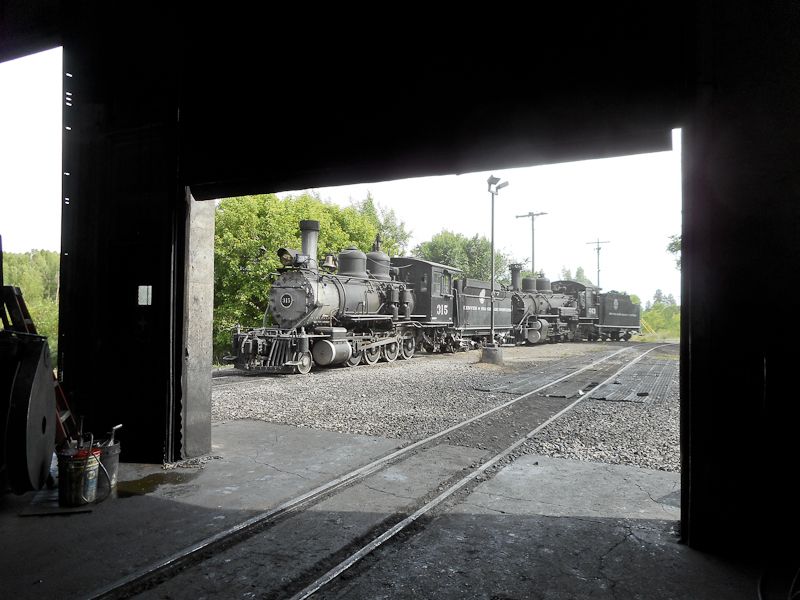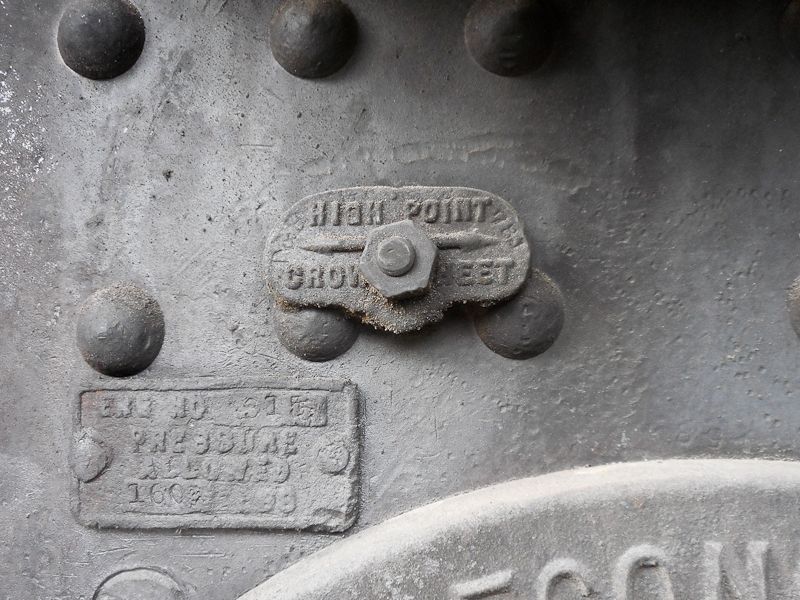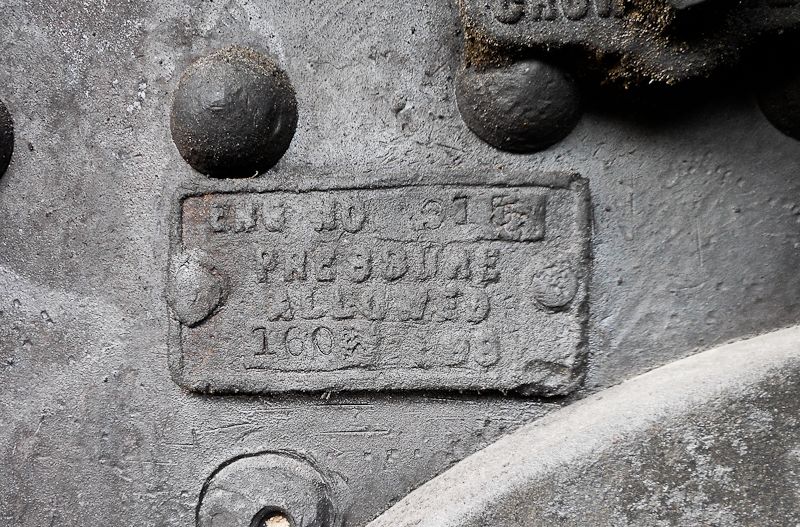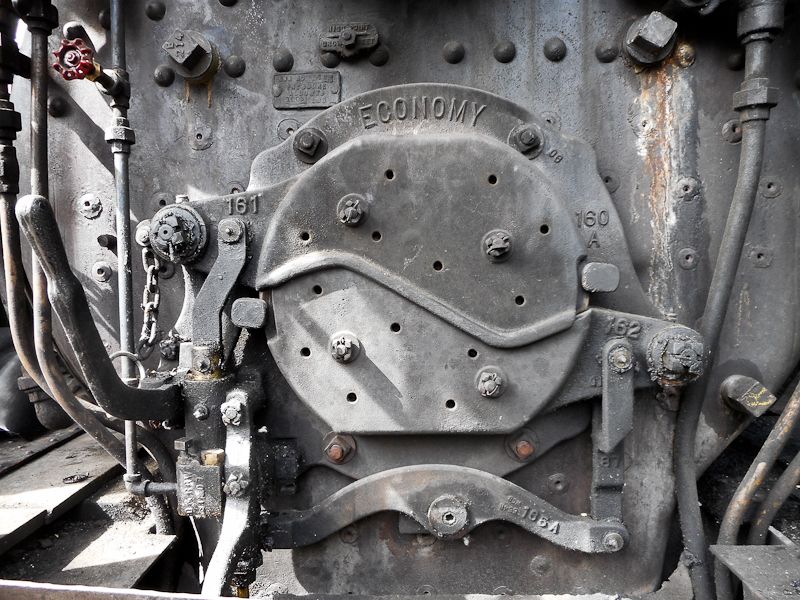My question is why is 315 not running in Durango for the Railfest?
Bob, I Don’t know. Really, I don’t know, I’m far to low on the totem pole to be in on those decisions. That decision was made by Senior 315 management ( Durango Railroad Historical Society ) and the Durango Silverton management.
I do know that our FRA annual for this year expires about July 22 ( I could be off by a few days there), and we would have to have it re-inspected. She is in some of the best shape she has ever be in, and as having done maintenance on her for the past year, she is in great shape. She would pass with flying colors tomorrow.
That being said. I don’t really know other then the annual inspection thing.
A few more pics from this week in Chama.
315 and 463 from inside the engine house.

A few detail shots.
This is the Danger marker attached to the boiler back head by the maker. It shows the level of the top of the crown sheet for this engine. You NEVER, EVER , EVER, let the water level get below this point in the boiler. IF you do then BOOM. And you will probably die.

You also have to keep in mind the tilt factor when running down hill on steep inclines as the water will slosh to the front of the boiler, leaving the crown sheet exposed. It won’t explode immediately, but it won’t take very long.
This is the Pressure tag attached by the builder showing the certified pressure for this boiler.

The three valves that make up the “Tri Cocks”. The tray under them is to catch the out put (drains to the ground) when you open the valves. These you use to make a positive check of the water level in the boiler. If you open the top one and get steam then you know the water level is lower then that point in the boiler. If you then open the middle one and get water, then you know that the boiler water level is between the two valves.

On the right is the “Water Glass” for the engineers side. There is another on the fireman’s side.
And the clam shell fire box door. It has an air operated opener triggered by a foot petal, and a manual lever.

More latter.
Thanks, Dave. I’m learning a lot with this thread…
I have really learned a lot on the running of a steam engine from this thread. I always wondered what those three valves on an incline were for…and now a question.
Are the “tri-cocks” meant as a back up to the water glass as to where the true level of water in the boiler really is??? Were the “tri-cocks” more useful in the uphill or down hill running of the locomotive as you mentioned above??
Thanks again for all the info and the really wonderful and clear pictures as we look over your shoulder and don’t get a bit greasy,dusty or dirty.
Doc Tom
I asked the same question on the Narrow Gauge forum and the answer I got was it costs $8000 each time 315 is operated for a large event and the group that owns the locomotive loses money and never breaks even. D&S just can’t sell enough tickets to make running 315 worth it. It looks like who ever is doing the books realizes they just can’t keep firing her up anytime the mood hits.
Bob, I don’t know where you got that figure from. The estimated cost of trucking 315 to and from Chama, with professional escorts is about that much. The last few times No escort was necessary, and for the D&S there is only the cost of switching out the loop in Silverton, to give access to the main.
For the 315 there is costs of Insurance, lube oils and greese, and incidentals. 315 also has to buy the coal from the RR that we use. All the crew are volunteers, and I have never received any monies for my costs. Someone did buy the crew dinner one night. Normally it’s out of pocket.
Tom, Yes, They are a positive physical check on the water level. Their use pre-dates the sight glasses
Even the sight glasses have there “Quirks”, and so there are a set of valves to control flow and bleed off and re-fill them. They are rather dependable simple, but not always 100% accurate, so you blow them down and re-fill. Also having two separate glasses, gives you a redundancy to be sure.
Hi Dave Taylor:
This is the most interesting post that I have ever read.
Later, can the web host create an archive of this post for all of our future reference?
Hi Jon Radder:
What is the internet address of this YouTube 315 video?
I watched from beginning to end. Of course, the highlight is the high rail section.
Another great posting.
Jon Radder
(http://www.largescalecentral.com/public/user/70/9e/01/19bd3_9bf1.JPG?c=8976)
- Candlewood Lake, New Fairfield, CT
- 9668 posts
December 18, 2013 8:52:24 AM EST
Happened across this 315 video on Youtube. Brings back memories of my chase of the Durango train in the summer of 2000.
Dave Taylor said:
Tom, Yes, They are a positive physical check on the water level. Their use pre-dates the sight glasses
Even the sight glasses have there “Quirks”, and so there are a set of valves to control flow and bleed off and re-fill them. They are rather dependable simple, but not always 100% accurate, so you blow them down and re-fill. Also having two separate glasses, gives you a redundancy to be sure.
Thanks Dave,
You are very knowledgeable about the workings of a steam locomotive. I agree this thread is one of the most interesting I have ever followed. Thanks so much for all the info and the great pictures!!!
Doc Tom
Dear All,
If you have some time, here is the report on the 1995 steam loco boiler explosion in PA.
http://www.ntsb.gov/doclib/safetystudies/sir9605.pdf
If you are short on time, skip down to the conclusions on p.48 of the report.
My quick interpretation:
Poor injector, boiler, sight glass and gage maintenance, plus lack of formal crew training.
Hope this helps.
Sincerely,
Joe Satnik
Edit: Add:
Wiki link to damaged steam loco 1278:
http://en.wikipedia.org/wiki/Canadian_Pacific_Railway_No._1278
Hello Norman -
That was a tough question to answer - had to find the original post in this huge thread. I did finally find it. A link to the video is: http://youtu.be/WGKvQavBsOE
You should have been able to watch it from the imbed in the post. To get to the actual Youtube page of any imbedded video just click on YouTube on the bottom of the imbedded viewer.
315 is tentatively scheduled to be moved to Silverton next week.
Yup, Directly to Silverton, without a stop in Durango. Original plans were to truck her to Durango, and then put her back together there, and run light to Silverton. Don’t know whats up with the D&S, but running to Silverton, isn’t going to happen. 
Oh wellllll…
Dave, really enjoying this thread.
Question: what is optimal water level, or optimal range? Just curious.
Thx.
Marty
Marty et el: Simple question, no easy answers.
Before I get into the answer, let me pre-face the following comments. I am a rookie fireman. I have a lot to learn about firing. I believe my comments below are right and correct. I fire on a 119 year old antique locomotive. What I have learned is from firing 315, the techniques we use may not be the same as used on a different (more modern) engine. That being said.
The first and most important thing is NEVER EVER let the water level get to low! BOOM!
Secondly, believe it or not, is Never let it get to high! As the water level gets to the point of filling the boiler completely full, the steaming ( generating of water to steam ) actually reduces as the “Head volume” ( the area of space between the water line and the top area of the boiler shell) decreases, less volume of stored (under pressure) steam. And if you overfill with water, you will run water into the “DRY pipe”, and then into the cylinders, and you will have “Hydro Lock” as the water will not compress, and probably blow the heads off your cylinders. Never a good thing to do.
Those are the two extremes. So the real answer is somewhere safely in-between. That seems overly simple, but it’s really not. The water level is actually used all the time to help control the “Steaming” and steam pressure as you run and put demands (loads) on the engine.
A good fireman fires for a mile down the track, in anticipation of the engines demands when you get there. You can’t do much to change the conditions in the boiler rapidly, You throw on more coal, but it takes a while to ignite, and to get burning and add to the heat stream. Not a rapid change to 1000 gallons of water. If you are pulling a heavy load ( pile driver OB +) up a extended grade, you use a lot of coal and a lot of water to make the needed steam, and keep the pressure as high as reasonably possible ( the goal is to manipulate the needed infusion of cold water, and just the right amount of coal), as the valve timing is way open ( giving a longer duration of steam feed to the cylinders per stroke ) you use a lot of steam.
When your drifting downhill everything goes to the other end of water usage, the valve timing is short ( using very little steam feed duration per stroke). Coal you put in a mile back, is now roaring and you are using very little steam to the cylinders, water usage is minimal, but you have a roaring fire producing a lot of steam, you add water to cool down the boiler to keep from setting off the POP OFF valves from to much pressure, but the water level is already high, so you dump water out the side ( using the Blow Down Valve ) to lower the pressure and the water level. Lowering the pressure also has the effect of lowering the boiling point (temperature) of the water, so you make more steam, but at a lower pressure, as the pressure starts to rise again, you add water to “cool things down” not because the level is low, and you can get into a kind of a runaway cycle.
When firing 315, we never want to leave a “Hole” in the fire, (a area on the grates with out any burning coal) as that can, and has, damaged the grates, so one has to keep a uniform fire across the bed at all times, even though you might not need much steam for the engine. You add water to “Cool things down”. Water level goes up, and steaming goes down. You try to reach a balance in controlling steam to water to coal. Water level is one of the tools you use.
Kinda a long answer to a short question.
If any clarification is needed, ask and I’ll do my best to get you on the right track.
FYI. The tender was transported to Silverton today, and is in the Silverton Northern’s Engine house.
The engine will be moved as soon as road permits and escorts can be arranged.
 I was unable to help in the move as the paying job got in the way.
I was unable to help in the move as the paying job got in the way.
I hate it when the paying job gets in the way!
Dave,
The most helpful tip I learned in firing was to listen to the engine. That will give you best indication as to how much work it’s doing and how much fuel you need on your fire. When you progress to running, listening to the engine will give you the best indication of how fast you’re going. I used the beats of 1 and 2 and 3 and 4, 1 'n 2 'n 3 'n 4, 1 2 3 4 to set my speed. I found the hardest part of running was to speed my speed consistent. One mile an hour two fast and you’ll be early, one mile an hour two slow and you’ll be late. Determining your speed without a speedometer is challenging.
Patrick
315 moves soon to Silverton. I won’t be there to help.
I write this from a hotel in Albuquerque, as Friday early AM we fly to Todd’s backyard Boston, to board a Holland American cruise ship Saturday for a 35 day cruise to the far north and Europe. The cruse is a treat for Marilyn and I for our 42nd anniversary.
As I don’t think that those small fishing villages on the North side of Iceland has very good internet service, I’ll probably be out of touch for a month.
I do plan to visit the Newfoundland National Railroad museum in Corner Brook. And I think I heard a rooster in the wings.
Friday night in Boston, and Saturday shipboard. I’ll touch base when I can.
Bon Voyage!